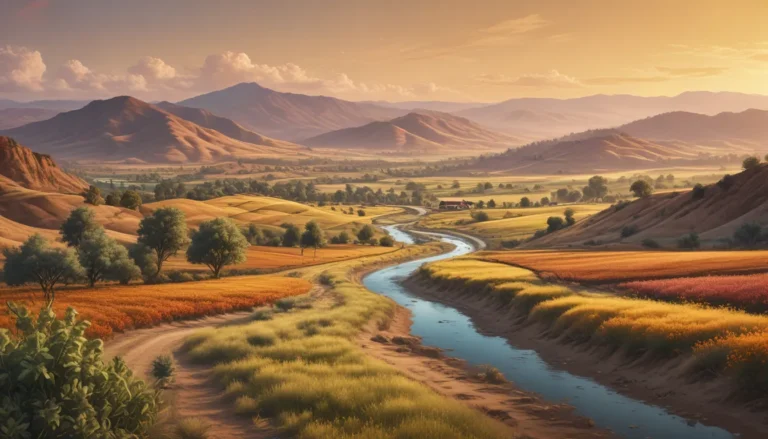A Note About Images: The images used in our articles are for illustration purposes only and may not exactly match the content. They are meant to engage readers, but the text should be relied upon for accurate information.
When we look up at the skies and feel the breeze on our faces, we are experiencing the wonders of our planet’s climate. The intricate dance between air pressure, temperature, and moisture creates the diverse weather patterns we encounter each day. From rainbows to thunderstorms, the Earth’s atmosphere is a dynamic and ever-changing system that influences every aspect of our lives.
The Troposphere: Where Climate Comes Alive
The troposphere, the lowest layer of the Earth’s atmosphere, is where all the magic of climate happens. Comprising 75% of the atmosphere, the troposphere holds 99% of the water vapor in the air. Despite our notion of a uniform atmosphere, it varies in thickness across the globe, being thicker over the tropics and thinner near the Arctic. This layer is where clouds form, winds blow, and most of Earth’s weather occurs.
Understanding Weather Phenomena: Air Pressure, Temperature, and Moisture
At its core, climate is a result of the interplay between air pressure, temperature, and moisture. Different combinations of these factors give rise to various weather phenomena. From tornadoes to blizzards, each type of storm is created by a unique mixture of these elements. For instance, tornadoes form when cold polar air clashes with warm tropical air at different altitudes, creating a swirling funnel of destruction.
- Frontal Rain: Occurs when two air masses collide.
- Orographic Rain: Caused by the shape of the land.
- Convective Rain: Results from instability in the atmosphere.
The World of Storms: Nature’s Powerful Forces
Earth is home to 13 distinct types of storms, each with its own characteristics influenced by geography and climate. From tornadoes to hurricanes, these storms have a significant impact on our planet. Windstorms, ice storms, hailstorms, and tropical cyclones are just a few examples of the diverse storms that shape our world. Understanding these storms helps us prepare and adapt to their effects.
- Tornadoes, windstorms, and squalls are recognized by their wind patterns.
- Hailstorms, blizzards, and thunderstorms bring unique precipitation.
- Tropical cyclones, known as typhoons or hurricanes, unleash powerful winds and rain.
Delving into Meteorology: Exploring the Science of the Atmosphere
Meteorology is the scientific study of the atmosphere, focusing on weather forecasting and understanding weather patterns. This interdisciplinary field bridges the gap between science and everyday life, providing us with essential knowledge to predict and respond to changing weather conditions. Meteorologists use advanced technology and data analysis to unravel the mysteries of the atmosphere.
The Pioneers of Weather Science: Aristotle and the Upanishads
Aristotle, the legendary philosopher, is credited as the father of meteorology for his groundbreaking work in understanding the hydrologic cycle. Centuries before Aristotle, the ancient Indian Upanishads described meteorological phenomena such as cloud formation and seasonal cycles. These early scholars paved the way for modern meteorology, shaping our understanding of the Earth’s climate.
Historical Encounters with Nature’s Fury: Christopher Columbus and Ferdinando de Medici
During his voyages, Christopher Columbus encountered a tropical cyclone, marking the first European account of such a storm. Meanwhile, Ferdinando II de Medici established the world’s first known weather observing network, gathering meteorological data across Europe. These pioneers laid the foundation for modern weather science, highlighting the importance of studying and predicting weather patterns.
Unusual Weather Wonders: From Pink Snow to Massive Hailstones
From pink snow in Colorado to gigantic hailstones in South Dakota, Earth’s climate never ceases to amaze us. Pink snow, caused by a unique algae species, adds a colorful touch to the winter landscape. Meanwhile, South Dakota holds the record for the largest hailstone, weighing nearly two pounds. These unusual weather phenomena remind us of the diverse and awe-inspiring nature of our planet’s climate.
Climate Concerns: From Record-Breaking Rainfall to Devastating Impacts
While we marvel at the wonders of climate, we also face its destructive power. Record-breaking rainfall in Maryland and devastating storms have taken a toll on human lives and economies. Severe weather events have cost trillions of dollars in economic losses and claimed hundreds of thousands of lives. As we witness the impacts of climate change, it’s essential to study and understand the forces that shape our planet’s weather.
Embrace the Beauty and Complexity of Climate
As we navigate the complexities of Earth’s climate, let us appreciate the beauty and intricacy of our planet’s weather systems. From towering thunderstorms to gentle rainbows, each weather phenomenon tells a story of nature’s power and resilience. By studying meteorology and understanding weather patterns, we can better prepare for the challenges and wonders that lie ahead. Let’s embark on a journey of discovery and awe as we explore the fascinating world of climate together.






